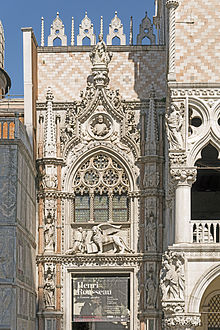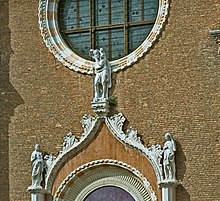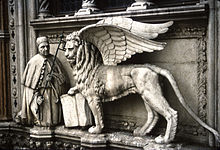Bartolomeo Bon
Bartolomeo Bon (* 1404 (?); † between 1464 and 1467) was a member of the famous Venice builder and sculptor family Bon from Bergamo . In secondary literature, the name also appears as Bartolomeo Buon or Bono. Bartolomeo Bon is regarded as a leading master builder and sculptor of Venetian architecture in the transition from the late Gothic to the early Renaissance .
Life
He was the son of the stonemason Zane Bon (approx. 1360-1443), from whom he was trained in the workshop in the municipality of San Marzilian . In a contract it says accordingly "lo Zuane Bon tajapiera de la contrada de San Marzilian e mio fio Bortolamio" ('Zuane Bon sculptors from the community of San Marzilian and my son Bortolamio')
Bartolomeo worked on the famous Ca 'd'Oro in Venice, the palace of Marin Contarini. The palace fountain is considered his first independent work, which was particularly difficult because the red Veronese marble used is particularly difficult to work with.
The structure, which bears the richest facade of any Venetian palace, was unusual in other respects as well. Marin Contarini managed the project very independently, so that the individual ideas can hardly be assigned to individual artists. In addition to the receipts, he hired Milanese artists and craftsmen under the direction of Matteo Raverti - a completely unusual way of fragmenting an order, which, however, also had enormous dimensions. Contarini coordinated the two teams. The Bon team was responsible for the loggia on the lowest floor, then for the windows and the crenellated crown, the tracery, while the Raverti team made the two upper loggias, the stairs in the inner courtyard and the land portal. In addition, the receipts were assigned almost all of the smaller tasks, so that despite this division of labor, they were Contarini's mainstay. The basic foundations of the palace were created by three other builders, the first of whom, Marco d'Amadio, died early. He was followed by a master Cristofolo, then Antonio di Martini.
With his work, Bartolomeo Bon recommended himself for a prestigious state commission, namely for the construction of the Porta Della Carta at the Doge's Palace , which connects the south wall of the Basilica di San Marco with the Piazzetta wing of the Doge's Palace, which was completed around 1438. On September 27, 1422, the Great Council decided to demolish the old and in poor condition Ziani Palace and to build a new, functional, but also splendid and representative building in its place - "in forma decora et convenienti", as it says in the corresponding minutes of the resolution. Construction began in 1424. Excellent works were attached to the north-west corner, such as the Judgment of Solomon, which was supposed to symbolize the sense of justice of the Republic of Venice, so that the planned Porta della Carta had to be set back significantly, i.e. had to be moved further from the square to the east, if this new one was wanted Do not lose masterpieces or move them to other locations. This is all the more true as this sculpture was attributed to Bartolomeo Bon.
Work on the portal probably began as early as 1433, before the Doge's Palace was completed at this point. Bartolomeo Bon signed his contract with the responsible Provveditori al Sal on November 10, 1438. These Proveditori supervised the salt monopoly and their enormous income was repeatedly used to finance state tasks. Bon was to receive the exorbitant sum of 1700 ducats , the construction time was 18 months. Tommaso Malipiero, Antonio Marcello, Paolo Vallaresso and Marco Moro signed on the Provveditori side .

Bartolomeo Bon enclosed a sketch with the contract in order to specify more precisely which tasks had to be carried out in detail. The contract including the sketch has been received. It turns out that these plans have been changed, because the four virtues that adorn the portal today are not mentioned, nor is the kneeling Doge Francesco Foscari in front of the Lion of St. Mark , who in turn appears in the contract. This was nothing unusual, because the contract for the large window on the lake side, i.e. the south facade of the Doge's Palace, which was closed with Masegne on October 2, 1400 , only hinted at the details that were carried out later.
The time of 18 months to completion stipulated in the contract between the Proveditors and Bartolomeo Bon was by no means complied with. A zetola from April 17, 1442 mentions that Bon was still busy with the portal. In it, Bon promised to complete the work within 12 months, otherwise he would be fined 100 ducats. The delays may have been due to the fact that the Four Virtues were passed on as subcontracts, so that deadline delays were more difficult to avoid. In addition, Bon himself worked on other construction sites, such as the Carità Church and the Scuola Vecchia della Misericordia. In addition, Bartolomeo's father, who was over 70 years old, died in 1443. When the Porta della Carta was finally finished, its main creator left his signature: “Opus Bartolomei” on the architrave - there is a copy there today.
Bon's partner, probably already at the time when his father was becoming frail, was Pantaleon di Paolo , from around 1442 at the latest. Bon meanwhile had several daughters, but no son who could be his successor. These two also fell behind with their work, so that they soon faced a fine of 200 ducats. It was about the now no longer existing Foscari staircase in the inner courtyard of the Doge's Palace. This time the Signoria even threatened him never to employ him again, which amounted to a threat of a kind of blacklist.
From 1440 to 1453 Bon worked on the church of Santa Maria della Carità , he designed the portal of the Madonna dell'Orto and the portal of San Zanipolo . On the other hand, the construction of the Ca 'del Duca , a monumental palace building on the Grand Canal northeast of the Accademia , which was only completed up to the ground floor and later integrated into the subsequent structure, remained unfinished . In addition, other works are attributed to Bon, such as the Francis statue at the west portal and the Emiliani chapel, both at the Frari church .
Bon worked from about 1420 to about the mid-1460s, and was the main builder in the city of Venice at the time. In his late creative phase he integrated Renaissance elements into his completed Gothic work.
literature
- Richard J. Goy: Building Renaissance Venice. Patrons, architects and builders, c. 1430-1500. Yale University Press, New Haven CT et al. a. 2006, ISBN 0-300-11292-0 , pp. 99-138.
Web links
- Bartolomeo Bon , Jan-Christoph Rößler , Venice
- La Porta della Carta , Musei Civici Venezia ( Memento from October 25, 2011 in the Internet Archive )
Remarks
- ↑ Quoted from Thomas Graham Jackson: Gothic Architecture in France, England, and Italy. Volume 2. Cambridge University Press, Cambridge 1915, p. 246, (Reprinted. Hacker Art Books, New York NY 1975, ISBN 0-87817-106-1 ).
- ↑ La porta della carta
- ^ Richard John Goy: Building Renaissance Venice. Patrons, Architects and Builders, c. 1430-1500 , Yale University Press 2006, p. 113.
| personal data | |
|---|---|
| SURNAME | Bon, Bartolomeo |
| ALTERNATIVE NAMES | Buon, Bartolomeo; Bono, Bartolomeo |
| BRIEF DESCRIPTION | Italian builder and sculptor |
| DATE OF BIRTH | between 1400 and 1410 |
| DATE OF DEATH | between 1464 and 1467 |




